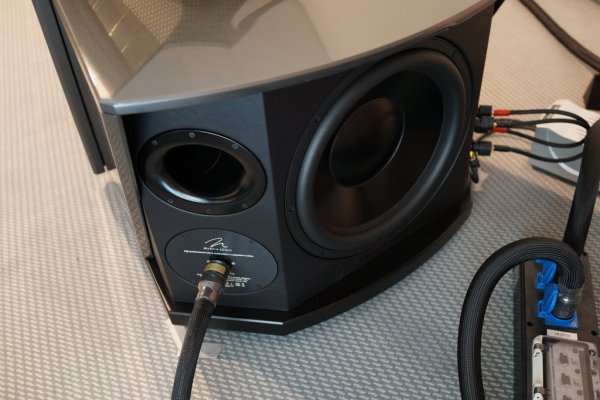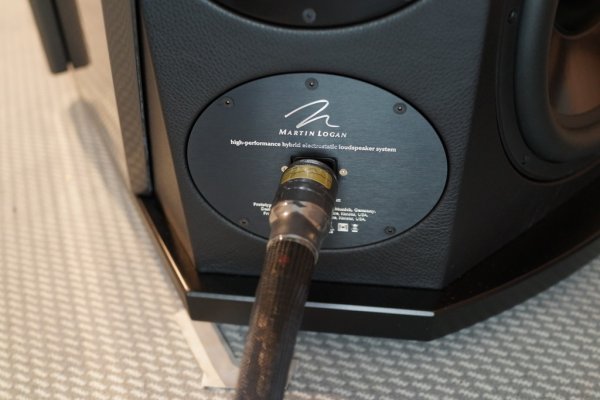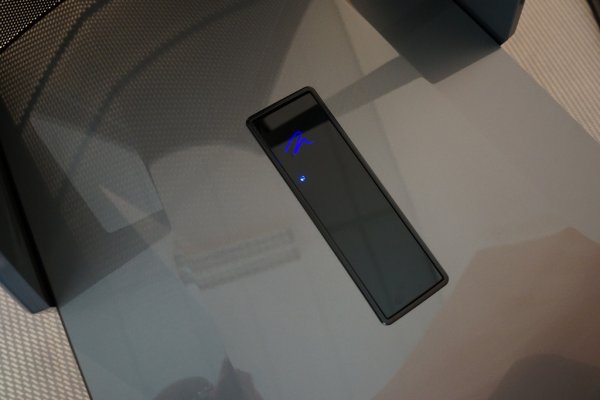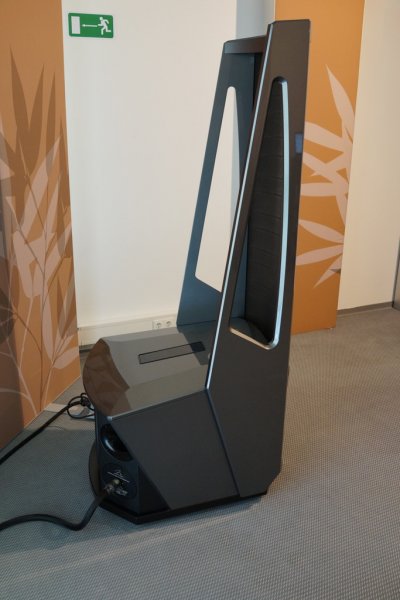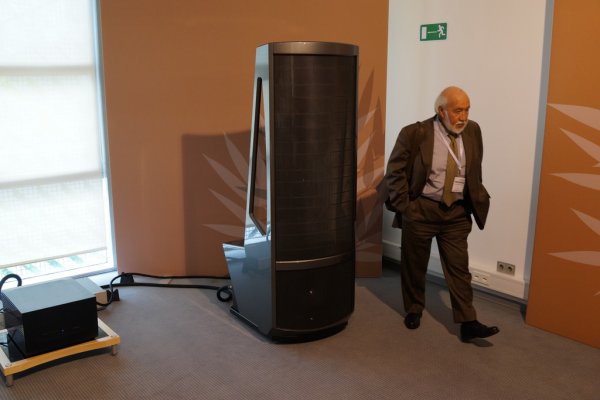Martin Logan Neolith
- Thread starter ack
- Start date
You are using an out of date browser. It may not display this or other websites correctly.
You should upgrade or use an alternative browser.
You should upgrade or use an alternative browser.
were i in the financial position to consider these speakers, they would be on the short list that includes the MBL101s which also take a boatload of power due to their omni radiation pattern.
This fits well with what I hoped ML would produce as a ref speaker, I just need to spend some time with them now, or maybe not ;-) Anyone know if there will be any at Newport Beach end of the month? I'll be there as an exhibitor, so would have to take time out to hear them along with some Rockports.. Good video lloyd!
Thanks for posting Elberoth...did you take these? Nice shots. How did they sound?
Yes, i did. I didn't have a chance to listen though - everytime i tried, the room was full.
The naming is indeed appropriate as this is basically the Monolith architecture but with an updated bass section. The panel is identical in size to the original Monolith, note the quote: "Neolith features a 22x48-inch electrostatic transducer ", and the original Monolith was also 22x48, but based on Gen1 panel tech (larger perfs, thicker stators).
So I'm happy to see a new iteration of the classic, but I'm not tempted in the least at that estimated price.
I also expect to see an active crossover version (Neolith X) within the year, possibly featuring DSP support for the 3-way x-over + two sub outputs with PBK (ML's room correction for subs). Again, the same approach used on the original Monoliths, which were offered in passive or active flavors.
The Monoliths were among the worst speakers i ever owned and ML was quite aware of all it's flaws; why would anyone want a speaker based on that disaster?
david
Great pictures Adam. The equality is excellent and thanks for showing the cables - the care in such details separates the true audiophile from the crowd just taking pictures. 
Just another big HYBRID not a true electrostatic i am a panel guy FIRST but if i had to choose between the Martin Logan Neolith or the MBL 101s it would be a no brainer MBL's all the way 
I don't care how good the speakers are, that music is awful!
I had the opportunity to hear these at a press event at Overture. They had a big and open sound with plenty of detail. Smooth and no harshness at all. The problem was the bass. I didn't find that they dug very deep. Kick drums and acoustic and electric bass was missing. I was able to discover this using test tracks. For me the best is the Duke's Big Four on XRCD. All the tracks are great but Cotton Tail and The Hawk Talks have exceptional drum tracks, about as real as drums get on a recording. On the Neoliths, the kick drum lacked the visceral impact I am used to hearing. The music that was played at the demo before were were able to play all of 2 of our own tracks really lacked deep bass. I think that the passive built in sub was the problem here. It just didn't cut it for me. The same for the price, $80k. I was able to play my tracks on another set of ML's that go for $25k. These speakers were each paired with the ML subwoofers in a similar sized room and sounded superb with excellent bass response. They sounded like the Neoliths but with bass. These speakers with the subs can be had for $35k and sounded better than the Neoliths. Still too rich for my blood plus I would gather that they would need a rather large room.
The Monoliths were among the worst speakers i ever owned and ML was quite aware of all it's flaws; why would anyone want a speaker based on that disaster?
david
Did you ever consider that other factors may have impacted / influenced your reaction to the speaker?
I was hoping this wasn't going to turn into an ML bashing thread.
I had the opportunity to hear these at a press event at Overture. They had a big and open sound with plenty of detail. Smooth and no harshness at all. The problem was the bass. I didn't find that they dug very deep. Kick drums and acoustic and electric bass was missing. I was able to discover this using test tracks. For me the best is the Duke's Big Four on XRCD. All the tracks are great but Cotton Tail and The Hawk Talks have exceptional drum tracks, about as real as drums get on a recording. On the Neoliths, the kick drum lacked the visceral impact I am used to hearing. The music that was played at the demo before were were able to play all of 2 of our own tracks really lacked deep bass. I think that the passive built in sub was the problem here. It just didn't cut it for me. The same for the price, $80k. I was able to play my tracks on another set of ML's that go for $25k. These speakers were each paired with the ML subwoofers in a similar sized room and sounded superb with excellent bass response. They sounded like the Neoliths but with bass. These speakers with the subs can be had for $35k and sounded better than the Neoliths. Still too rich for my blood plus I would gather that they would need a rather large room.
Interesting...i guess one question is: If you added dual subs to the Neoliths...do you think it challenges the big expensive reference towers (XLF, Grande Utopia EM, etc?) It seems based on your reaction that it was a good speaker but not a great speaker which was obviously better in mids/upper than the $25K ML (presumably the CLX)?
Listening impressions http://www.cnet.com/news/this-high-end-speaker-costs-the-same-as-a-mercedes-benz-cls/
I must admit some disappointment
i am happy to have super CLX
But super prodigy no way
having owned both i would not go back to a hybrid
Prodigies only worked with me in a very very large room
Clx much more forgiving
I though a better idea would be manepan quad approach of more bass panels
Well i haven't heard them
And they might be great
but i am not sure they would work in a lot of rooms
but be happy to be proved wrong....
i am happy to have super CLX
But super prodigy no way
having owned both i would not go back to a hybrid
Prodigies only worked with me in a very very large room
Clx much more forgiving
I though a better idea would be manepan quad approach of more bass panels
Well i haven't heard them
And they might be great
but i am not sure they would work in a lot of rooms
but be happy to be proved wrong....
I heard these at this past CES. It was some of the worst sound at the show. They are so ugly in person and would never own them period.
Really?!
The Neolith, with the largest panel ML has made to date -- really? 22" x 48"? I have a pretty good eye, so decided to measure my CLS panel. OK, so it's an inch shy in both directions: 21" x 47". I'd say that's negligible.
Now about those woofer sections. What I've discovered over 25 years of living with my ML electrostats, and listening to all kinds of other designs/offerings, is that no one (including ML, and Sanders) has ever been able to make a "hybrid" electrostat (that is, an ES panel + an EM woofer per side) that will create the same sound field as a truly "full range" electrostat would, if possible. It simply has to be full-range-all-electrostat, or nothing (more on why in a minute.) The best (or closest) examples we have, of full-range electrostatic panels, are the big Soundlabs, the nearly-as-full-range CLS, and the barely qualifying CLX. In fact, the Soundlabs are the only ones that can be considered truly full-range; although at the lowest frequency registers, their output has a hard time "keeping up", so to speak.
If you have a pair of electrostatic panels that go down respectably low (Soundlab - 24Hz, CLS - 32Hz, CLX -52Hz) and that produce a credible sonic hologram (sound field) on their own, then the job is NOT to add/match bass to each panel in the form of a non-electostatic driver! The out-of-control phasing alone just screws up the whole sound field! And if the panels themselves don't go low enough, as was begun with the Statements for example, the problems are further compounded, because the EM low frequency drivers now have to produce sound above 100Hz, which suddenly makes them easy to locate, and therefore to separate out from the panels! This approach is a disaster. It always was and always will be. Which is why those with the money and the space finally wind up with Soundlabs, if the wife allows.
The best solution, for adding more bass to the limited low frequency output of (even the most full range) electrostatic panels, is to somehow match a "bass sound field" (below say 30Hz - 40HZ) to the electostatic sound field produced by the panels above that frequency.
So. What are the characteristics of a stereo sound field produced by a pair of electrostatic panels? Well first, as we all know, the front-propagating wave is 180 degrees out-of-phase with the rear-propagating wave. Second, there is an approximately 20 degree "null" area extending from the left and right edges of each panel -- due to frequency cancellation between the front and rear waves. And third, and most important to keep in mind, the frequency response of even the most full range electrostatic panels falls off significantly below 80Hz - which just so happens to be the very point at which sound becomes non-directional to human perception! This is important to remember because if you can limit your need for bass augmentation to below 100Hz, and preferably below 40Hz (which is entirely possible with the full-range panels I mentioned,) then you don't need two sources of bass in order to preserve the soundstage!
OK. So what would be the characteristics of a "bass sound field" that could be easily superimposed on the holographic sound field already created by the panels? Well first of all, it would only need to have a single source, since there would be no need to create a "stereo image" at frequencies below that magic 100Hz. Second, the bass transducer/driver would need to be in the same plane as the one formed by the two panels, in order that the bass wave be "launched" from the same point (time-aligned) as the wave(s) produced by the panels. And third, the front-facing half of the low frequency wave would need to be 180 degrees out-of-phase with the rear-facing half.
The simplest, most obvious (and oldest!) solution would be to mount a woofer in an infinite baffle, and position it right between and in line with the panels, and it's done! Well not quite, unfortunately. First of all, placing a large enough (infinite?) baffle in that location would all but destroy the soundstage created by the panels. And expecting a woofer mounted in an infinite baffle to have transient response (fast enough) to match that of the panels is out of the question. So alas, an enclosure of some kind is needed.
The most respected dipole subwoofer design (front and rear drivers in a single enclosure, connected out of phase) is this one: http://www.linkwitzlab.com/woofer.htm but I think you have to build it yourself (none available commercially, I don't think); and custom tailor it's characteristics to your panels, amplifier, etc. A simpler (OK, more expedient!) solution would be to purchase a subwoofer with an omnidirectional radiating pattern, and set its phase response to 90 degrees (splitting the difference between 0 deg. and 180 deg.). The candidates would be one of the better down-firing subs (with good transient response, of course!) or one of the "Balanced Force" ML subs: the old Depth/Descent, or their current offering 210 and 212. I'm partial to the Depth/Descent, but only because the newer units use DSP (digital signal processing) and I prefer to keep all digitizing, when necessary, on the other side of my preamp, if you know what I mean!
This arrangement has provided me with electrostatic bliss for many years:
1. Full range electrostatic panels, with the low frequency response allowed to decay naturally (no low-pass cut off.)
2. A single, omnidirectional subwoofer, centered exactly between the panels left/right and front/back; with phase response set to 90 degrees, and high-pass set near or just below the lowest frequency response of the panels (usually somewhere between 30Hz and 50Hz)
3. Set level to taste, but keep it lower than you think it should be
And as for the "amazing" new (now TOTALLY PASSIVE, mind you!) ML Neolith? I ain't buying it! Literally and figuratively!
The Neolith, with the largest panel ML has made to date -- really? 22" x 48"? I have a pretty good eye, so decided to measure my CLS panel. OK, so it's an inch shy in both directions: 21" x 47". I'd say that's negligible.
Now about those woofer sections. What I've discovered over 25 years of living with my ML electrostats, and listening to all kinds of other designs/offerings, is that no one (including ML, and Sanders) has ever been able to make a "hybrid" electrostat (that is, an ES panel + an EM woofer per side) that will create the same sound field as a truly "full range" electrostat would, if possible. It simply has to be full-range-all-electrostat, or nothing (more on why in a minute.) The best (or closest) examples we have, of full-range electrostatic panels, are the big Soundlabs, the nearly-as-full-range CLS, and the barely qualifying CLX. In fact, the Soundlabs are the only ones that can be considered truly full-range; although at the lowest frequency registers, their output has a hard time "keeping up", so to speak.
If you have a pair of electrostatic panels that go down respectably low (Soundlab - 24Hz, CLS - 32Hz, CLX -52Hz) and that produce a credible sonic hologram (sound field) on their own, then the job is NOT to add/match bass to each panel in the form of a non-electostatic driver! The out-of-control phasing alone just screws up the whole sound field! And if the panels themselves don't go low enough, as was begun with the Statements for example, the problems are further compounded, because the EM low frequency drivers now have to produce sound above 100Hz, which suddenly makes them easy to locate, and therefore to separate out from the panels! This approach is a disaster. It always was and always will be. Which is why those with the money and the space finally wind up with Soundlabs, if the wife allows.
The best solution, for adding more bass to the limited low frequency output of (even the most full range) electrostatic panels, is to somehow match a "bass sound field" (below say 30Hz - 40HZ) to the electostatic sound field produced by the panels above that frequency.
So. What are the characteristics of a stereo sound field produced by a pair of electrostatic panels? Well first, as we all know, the front-propagating wave is 180 degrees out-of-phase with the rear-propagating wave. Second, there is an approximately 20 degree "null" area extending from the left and right edges of each panel -- due to frequency cancellation between the front and rear waves. And third, and most important to keep in mind, the frequency response of even the most full range electrostatic panels falls off significantly below 80Hz - which just so happens to be the very point at which sound becomes non-directional to human perception! This is important to remember because if you can limit your need for bass augmentation to below 100Hz, and preferably below 40Hz (which is entirely possible with the full-range panels I mentioned,) then you don't need two sources of bass in order to preserve the soundstage!
I'm hoping there are no strong objections so far? 
OK. So what would be the characteristics of a "bass sound field" that could be easily superimposed on the holographic sound field already created by the panels? Well first of all, it would only need to have a single source, since there would be no need to create a "stereo image" at frequencies below that magic 100Hz. Second, the bass transducer/driver would need to be in the same plane as the one formed by the two panels, in order that the bass wave be "launched" from the same point (time-aligned) as the wave(s) produced by the panels. And third, the front-facing half of the low frequency wave would need to be 180 degrees out-of-phase with the rear-facing half.
The simplest, most obvious (and oldest!) solution would be to mount a woofer in an infinite baffle, and position it right between and in line with the panels, and it's done! Well not quite, unfortunately. First of all, placing a large enough (infinite?) baffle in that location would all but destroy the soundstage created by the panels. And expecting a woofer mounted in an infinite baffle to have transient response (fast enough) to match that of the panels is out of the question. So alas, an enclosure of some kind is needed.
The most respected dipole subwoofer design (front and rear drivers in a single enclosure, connected out of phase) is this one: http://www.linkwitzlab.com/woofer.htm but I think you have to build it yourself (none available commercially, I don't think); and custom tailor it's characteristics to your panels, amplifier, etc. A simpler (OK, more expedient!) solution would be to purchase a subwoofer with an omnidirectional radiating pattern, and set its phase response to 90 degrees (splitting the difference between 0 deg. and 180 deg.). The candidates would be one of the better down-firing subs (with good transient response, of course!) or one of the "Balanced Force" ML subs: the old Depth/Descent, or their current offering 210 and 212. I'm partial to the Depth/Descent, but only because the newer units use DSP (digital signal processing) and I prefer to keep all digitizing, when necessary, on the other side of my preamp, if you know what I mean!
This arrangement has provided me with electrostatic bliss for many years:
1. Full range electrostatic panels, with the low frequency response allowed to decay naturally (no low-pass cut off.)
2. A single, omnidirectional subwoofer, centered exactly between the panels left/right and front/back; with phase response set to 90 degrees, and high-pass set near or just below the lowest frequency response of the panels (usually somewhere between 30Hz and 50Hz)
3. Set level to taste, but keep it lower than you think it should be
And as for the "amazing" new (now TOTALLY PASSIVE, mind you!) ML Neolith? I ain't buying it! Literally and figuratively!
Agree 100% REAL electrostats are full range, as far as I am concerned hybrids are NOT electrostats no matter how good they may be, my Acoustat 1+1s go down to 30hz and that is low enough for me, most important it is bass from a panel not a woofer.
Similar threads
- Replies
- 148
- Views
- 10K
- Replies
- 10
- Views
- 2K
- Replies
- 0
- Views
- 1K
| Steve Williams Site Founder | Site Owner | Administrator | Ron Resnick Site Owner | Administrator | Julian (The Fixer) Website Build | Marketing Managersing |


